Third-Order Leader-Following Consensus in a Nonlinear Multiagent Network via Impulsive Control
Abstract
Many facts indicate that the impulsive control method is a finer method, which is simple, efficient, and low in cost, for achieving consensus. In this paper, based on graph theory, Lyapunov stability theory, and matrix theory, a novel impulsive control protocol is given to realize the consensus of the multiagent network. Numerical simulations are performed to verify the theoretical results.
1. Introduction
In the past few years, consensus of multiagent networks has been intensively studied in many fields, such as biological, social, mathematical, and physical sciences ones [1–5]. Generally speaking, consensus refers to designing a system algorithm or protocol such that all agents asymptotically reach an agreement on their states. In particular, leader-following consensus means that there exists a virtual leader which specifies an objective for all agents to follow. Recently, some first-order and second-order leader-following consensus problems were discussed by lots of researchers [6–10], and then some novel system algorithms were given via some different control methods, such as pinning control, delay coupling control, adaptive control, and impulsive control [9–14]. In addition, Qin et al. considered consensus in the second-order multiagent system with communication delay in [15, 16]. Particularly, some multiagent networks cannot be controlled continuously. At this time, the impulsive control becomes a more desirable alternative. The impulsive control is low in cost and then has been widely applied in many fields, such as information science, system control, life science, communication security, and space techniques [17–19]. In the above senses, the impulsive control is very effective for achieving consensus of a multiagent network.
In some real networks, the connections between part nodes are sometimes a failure, and then the network topology may dynamically change over time. Therefore, it is indispensable to consider the case that the network topology is switching. As much as we know, most of the relevant studies focus on second-order consensus for multiagent networks [11, 12]. When the agent states are influenced by speeds, positions, and accelerations, it is necessary and significative to research the third-order consensus problem of a multiagent network with switching topology. At present, just few works considered the third-order consensus problem. In [20], adaptive third-order leader-following consensus of a nonlinear multiagent network with perturbations was addressed, without using the impulsive control method. In [11], impulsive consensus problem of second-order multiagent network with switching topologies was investigated, without considering its own dynamics. In this paper, we consider the third-order consensus problem in a multiagent network with the aforementioned four characters, that is, leader-following, own dynamics, switching topology, and impulsive control. By using the graph theory, Lyapunov stability theory, and matrix theory, some sufficient conditions are obtained to realize the third-order leader-following consensus.
The rest of this paper is designed as follows. Some necessary preliminaries are stated in Section 2. The consensus of a multiagent network is discussed in Section 3. Numerical examples are given to verify the theoretical results in Section 4. Finally, in Section 5, conclusions are presented.
2. Preliminaries
2.1. Multiagent Network
A directed path from node i to node j in the directed graph G is a sequence of edges (i, j1), (j1, j2), …, (jl, j) with distinct nodes jk, k = 1, …, l. A digraph G has a directed spanning tree if there exists at least one node called root which has a directed path to all the other nodes.
For a leader-follower multiagent network, suppose that the leader (labeled by 0) is denoted by node 0, and the followers are denoted by the nodes 1,2, …, N. The graph is consisting of the leader and the followers with communication topology. The connection weight between the ith follower and the leader is represented by bi, i ∈ V. If the ith follower is connected to the leader, then bi > 0; otherwise, bi = 0. Let B = diag {b1, b2, …, bN}.
Following, we address the multiagent network with switching topology. The set is used as a set of the graphs with all possible topology, which includes all possible graphs (involving N agents and a leader). We define a switching signal τ : [0, +∞) → P = {1,2, …, m}, which determines the topology structure that corresponds to the network. When the topology is switching, the Laplacian matrix L and the matrix B are also switching, which are denoted by Lτ(t) and Bτ(t).
The following assumptions are needed to derive our main results.
Assumption 1 (see [21].)Assume that there exists a constant γ > 0, such that the vector-valued function f satisfies the condition
2.2. Impulsive Control System
Impulsive control systems can be classified into three types based on the characteristics of plants and control laws [22].
Definition 2 (see [22].)For t ≠ τk(X), we define the time derivative of the function V(t, X) with respect to system (3) as
Type-II and type-III impulsive control systems and more theoretical results are present in [22].
In this paper, a type-I impulsive control system is considered.
3. Main Results
Definition 3. Denote exi(t) = ∥xi(t) − x0(t)∥, evi(t) = ∥vi(t) − v0(t)∥ and eui(t) = ∥ui(t) − u0(t)∥. The multiagent network (7) with the virtual leader (6) is said to achieve third-order leader-following consensus if the solution of (8) satisfies lim t→+∞ exi(t) = 0, lim t→+∞ evi(t) = 0, and lim t→+∞ eui(t) = 0, i = 1,2, …, N for any initial condition.
Basing on graph theory, Lyapunov function method, matrix theory, and the proof of Theorem 1 in [11], we have the following theorem.
Theorem 4. Under Assumption 1, if there exists 0 < φ < 1 such that
Proof. Consider the following Lyapunov function:
For , similar to the proof of Theorem 1 in [11], we have
Remark 5. According to the proof of Theorem 4, it is not necessary that all the graphs G1, G2, …, Gm have directed spanning tree.
On the basis of Gersgorin disk theorem [23], we get μ ≤ 2(γ + 1). For , accordingly, δk is equal to the maximum eigenvalue of (InN×nN + (Lτ(k) + Bτ(k)) ⊗ Ck) T(InN×nN + (Lτ(k) + Bτ(k)) ⊗ Ck). Therefore, we have the following Corollary 6 (recalling Δtk = tk − tk−1 ≤ ρ and P = {1,2, …, m}).
4. Numerical Simulations
In this section, we give some numerical examples to verify the theory results given in the previous section.
Following, we consider that the topology of the multiagent network is switching (P = {1,2}).
Example 7. Assume that the graphs G1, G2 have directed spanning trees. The directed spanning trees of G1, G2 are described in Figures 1 and 2. The corresponding matrices of the graphs G1, , G2, are A1, B1, A2, B2, respectively, where
Let the equidistant impulsive interval Δtk = tk − tk−1 = 0.00005. Then, ρ = 0.00005. There exists φ = 0.9995, which satisfies the inequality (23) of Corollary 6. From Figures 3, 4, and 5, we can see that the position errors exi(t), the velocity errors evi(t), and the acceleration errors eai(t) converge to zero quickly.
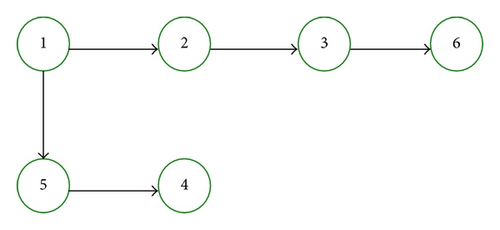

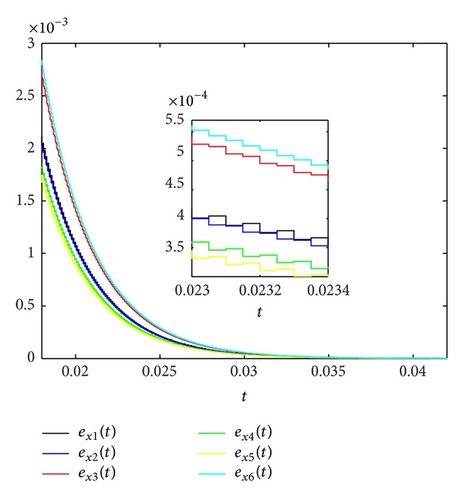
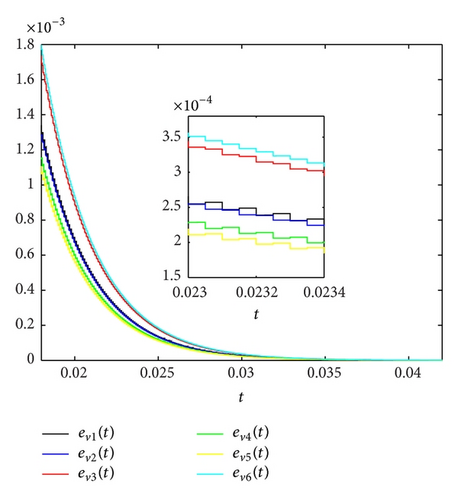

Example 8. Assume that the graphs G1, G2 do not contain directed spanning trees. Let the corresponding matrices of the graphs G3, , G4, be A3, B3, A4, B4, respectively, where
Similar to Example 7, in time intervals [t4k−1, t4k), the corresponding matrices are A4, B4, k = 1,2, …, while in other time intervals, the corresponding matrices are A3, B3. We choose the impulsive gain Ck3, Ck4 with topology and , respectively, as follows:
Let the equidistant impulsive interval Δtk = tk − tk−1 = 0.00005. Then, ρ = 0.00005. By some calculations, we can know that there exists φ = 0.9995, which satisfies the inequality (23) of Corollary 6. From Figures 6, 7, and 8, we can see that the position errors exi(t), the velocity errors evi(t), and the acceleration errors eai(t) converge to zero quickly. It shows that the condition on a directed spanning tree is not necessary to realize consensus of the multiagent network (7) under the impulsive control. In addition, the researchers considered the second-order multiagent system with communication delay in [21, 22]. In our future work, we will study the third-order consensus problem for the multiagent systems with communication delay.

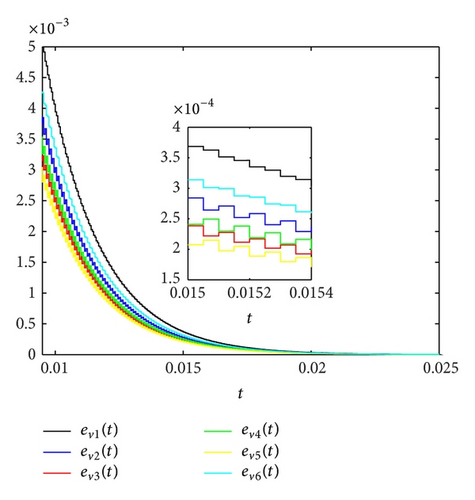
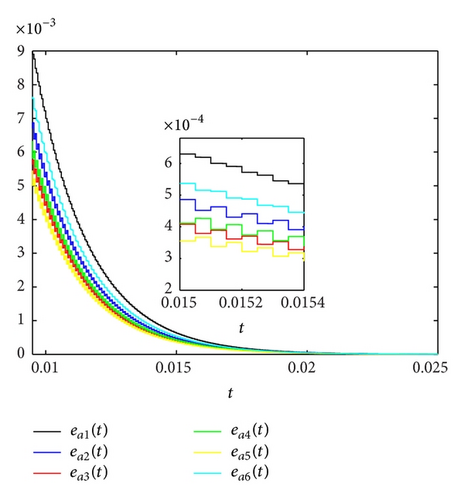
5. Conclusion
By using graph theory, Lyapunov stability theory, and matrix theory, third-order leader-following consensus problem of a nonlinear multiagent network is studied in this paper. By designing proper impulsive controllers, a new criterion on realizing consensus in the multiagent network with switching topology is achieved. Finally, numerical simulations are provided to illustrate the theoretical results. In our future work, we will study the third-order consensus problem for the multiagent systems with communication delay.
Acknowledgments
This work was supported by the National Natural Science Foundation of China (nos. 60964006, 61004101, and 11162004) and the Science Foundation of Guangxi Province, China (no. 2013GXNSFAA019006).




